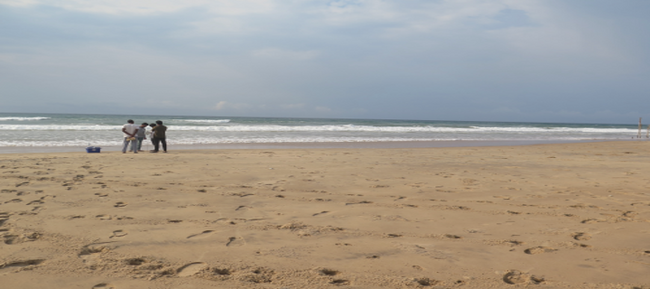Nutrient pollution poses a significant threat to coastal areas and understanding how they travel from groundwater into coastal ecosystems, particularly through subterranean estuaries (STEs), is crucial for maintaining marine health. Subterranean estuaries are zones where fresh groundwater from the land mixes with seawater.
While the role of surface estuaries (where rivers meet the sea) in regulating nutrient flow is well-studied, the role of STEs remains less understood. Our project aims to bridge this knowledge gap by exploring nutrient transformations and movements through STEs in different climatic and geographical settings.
This research is a collaborative effort between two groups: one from Jawaharlal Nehru University (JNU) in New Delhi, India, led by Prof. Dr. N. J. Raju, and the other from the Leibniz Centre for Tropical Marine Research (ZMT) in Bremen, Germany, led by Prof. Dr. N. Moosdorf. Both teams specialize in studying submarine groundwater discharge (SGD) and its associated nutrient fluxes but approach the topic from different perspectives and methodologies. This complementary expertise will enhance the research outcomes and foster a strong collaborative relationship.
The project's main goals are to quantify nutrient budgets via SGD at two locations: the Odisha Coast in India and in Königshafen, Sylt in Germany, and to understand how climate and local land use influence nutrient fluxes within the STE in these areas. The collaboration between JNU and ZMT not only advances scientific knowledge but also builds long-term research partnerships.
Nutrient pollution poses a significant threat to coastal areas and understanding how they travel from groundwater into coastal ecosystems, particularly through subterranean estuaries (STEs), is crucial for maintaining marine health. Subterranean estuaries are zones where fresh groundwater from the land mixes with seawater.
While the role of surface estuaries (where rivers meet the sea) in regulating nutrient flow is well-studied, the role of STEs remains less understood. Our project aims to bridge this knowledge gap by exploring nutrient transformations and movements through STEs in different climatic and geographical settings.
This research is a collaborative effort between two groups: one from Jawaharlal Nehru University (JNU) in New Delhi, India, led by Prof. Dr. N. J. Raju, and the other from the Leibniz Centre for Tropical Marine Research (ZMT) in Bremen, Germany, led by Prof. Dr. N. Moosdorf. Both teams specialize in studying submarine groundwater discharge (SGD) and its associated nutrient fluxes but approach the topic from different perspectives and methodologies. This complementary expertise will enhance the research outcomes and foster a strong collaborative relationship.
The project's main goals are to quantify nutrient budgets via SGD at two locations: the Odisha Coast in India and in Königshafen, Sylt in Germany, and to understand how climate and local land use influence nutrient fluxes within the STE in these areas. The collaboration between JNU and ZMT not only advances scientific knowledge but also builds long-term research partnerships.





